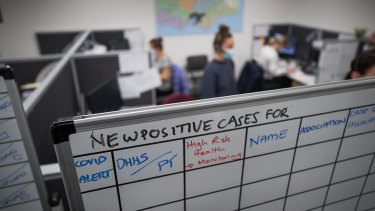Home » World News »
The questions suspected COVID-19 cases are asked
They are the open-ended questions that aim to stop the deadly spread of coronavirus.
Have you caught public transport? Have you visited a public site like a shopping centre or train station? Have you dropped a child off at childcare?
In Victoria, contact tracers working the phones are armed with a detailed 11-page questionnaire that guides them through interviews with suspected COVID-19 cases .
As federal Health Minister Greg Hunt demands that Victoria improve its systems, The Age has obtained the questions that the state's contact tracers put to cases.
The questions have been tweaked during the pandemic, prompting disease detectives to ask questions about hospitalisations, symptoms, comorbidities and risk history including recent travel or contact with a confirmed case.
Cases are asked to detail their movements for the fortnight before falling ill and then the 48 hours prior to and since displaying symptoms. They are asked who they were with, what they did, where they went and how long they stayed.
Mary-Louise McLaws, a UNSW epidemiologist and World Health Organisation COVID-19 advisor, said a good set of questions ensured contact tracers worked quickly and efficiently to "help with the burden of memory".
“It is a very emotive time for the person on the other end of the phone,” she said.
“The contact tracer needs to go through it with as much speed and empathy as possible. It is pretty hard.”
Professor McLaws said contact tracers should steer clear of pejorative language to ensure COVID-19 victims didn’t feel judged.
“During SARS people were slow to tell you things that were important because they were fearful of being value-judged," she said. "The same thing happened with HIV.”
She would like government to gather feedback from COVID-19 victims about their experience with contact tracers to see what could have worked better.
UNSW epidemiologist Mary-Louise McLaws.Credit:Dominic Lorrimer
A Department of Health and Human Services spokesman said COVID-19 was wildly infectious and contact tracers needed to ask more detailed questions about people's movements than they did for other communicable diseases.
"As we have learnt more about the disease we have refined and developed our contact tracing questionnaire to ensure it continues to be evidence based and current," he said.
The COVID-19 questionnaire used in Victoria appears less prescriptive than the one used in NSW.
NSW contact tracers read from a detailed questionnaire that resembles a call centre script.
It includes prompts such as: “Can you please take me through the two weeks leading up to the onset of your symptom? A calendar or diary, work roster, phone photos, credit or debit card information, might help."
Contact tracers run through a series of questions with cases to stop the deadly spread of the virus.Credit:Jason South
Professor Mark Stoove, an infectious disease expert from the Burnet Institute, said the most effective contact tracers did not robotically read through questions.
“A good contact tracer is someone who is able to engage in a conversation," he said. "They develop rapport with the case.”
Professor Stoove said that because coronavirus was so contagious, the questions had to be more comprehensive than those used for other communicable diseases such as measles and HIV.
“They need to know exactly your whereabouts for different times of the day, precisely the names of all the people you come in close contact with," he said. "It is much more complex.”
Contact tracing identifies, assesses and manages people who have been exposed to a disease to stop its spread.
The Andrews government has been desperately trying to rebuild public confidence in the state's contact tracing system, which has been blamed for helping fuel Victoria's second deadly wave of coronavirus.
Victorian health officials will soon visit Sydney to study NSW's contact tracing efforts, while the state government announced on Tuesday it would move to a NSW-style model where community hubs tackle outbreaks using local knowledge.
New technology including artificial intelligence has also been rolled out in an effort to improve the Victorian system.
Sign up to our Coronavirus Update newsletter
Get our Coronavirus Update newsletter for the day’s crucial developments at a glance, the numbers you need to know and what our readers are saying. Sign up to The Sydney Morning Herald’s newsletter here and The Age’s here.
Most Viewed in National
Source: Read Full Article




